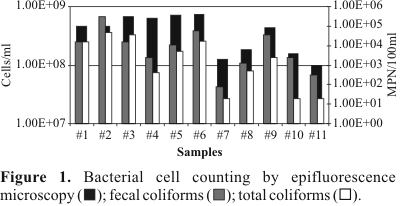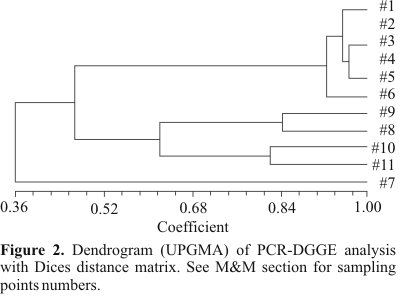Abstracts
Rodrigo de Freitas lagoon is an eutrophic aquatic environment. The waters from the lagoon are released to the sea at Ipanema and Leblon beaches, through Jardim de Alah channel. In this work, the influence of these waters on the bacterial communities of these beaches was investigated. Eleven sampling stations were set between the lagoon and the beaches, and the samples were analyzed by molecular and microbiological parameters. PCR-DGGE of the DNA extracted from the samples was performed using rpoB primers. Preliminary results indicate that all used approaches could reveal the influence of the lagoon on the beaches bacterial communities.
DGGE; diversity; bacterioplankton; eutrophic lagoon
A lagoa Rodrigo de Freitas é um ambiente aquático eutrofizado, cujas águas são lançadas ao mar nas praias de Ipanema e Leblon através do canal do Jardim de Alah. Nesse trabalho, foi estudada a influência desse aporte na comunidade bacteriana dessas praias. Para isso coletou-se água de onze estações distribuídas entre a lagoa e as praias. Essas amostras foram analisadas quanto a parâmetros moleculares e microbiológicos. Foi realizado também PCR-DGGE utilizando-se iniciadores para o gene rpoB, a partir de DNA extraído das amostras de água coletadas. Resultados preliminares mostram que a influência da lagoa na comunidade bacteriana das praias pode ser verificada por todas as abordagens.
DGGE; diversidade; bacterioplancton; lagoa eutrófica
ENVIRONMENTAL AND SOIL MICROBIOLOGY
Use of molecular approach to verify the influence of a eutrophic lagoon in the nearby ocean's bacterioplankton communities
Uso de metodologia molecular para verificar a influência de uma lagoa eutrófica na comunidade bacterioplanctônica do oceano adjacente
Rodrigo Gouvêa TaketaniI; Fábio Vieira AraujoII; Margaretha Denise Maria van WeereltIII; Maria Leonisa Sanchez-NunezIII; Erick AniszewskiI; Alexandre Soares RosadoI
ILaboratório de Ecologia Microbiana Molecular, Instituto de Microbiologia, Universidade Federal do Rio de Janeiro, Rio de Janeiro, RJ, Brasil
IIDepartamento de Ciências, Faculdade de Formação de Professores, Universidade Estadual do Rio de Janeiro, Rio de Janeiro, RJ, Brasil
IIILaboratório de Microbiologia Marinha, Instituto de Biologia, Universidade Federal do Rio de Janeiro, Rio de Janeiro, RJ, Brasil
Correspondence Correspondende to: Alexandre Soares Rosado Instituto de Microbiologia Universidade Federal do Rio de Janeiro Prof. Paulo de Góes, CCS - Bloco I - Lab 045, Ilha do Fundão, 21941-590 Rio de Janeiro, RJ, Brasil E-mail: asrosado@micro.ufrj.br
ABSTRACT
Rodrigo de Freitas lagoon is an eutrophic aquatic environment. The waters from the lagoon are released to the sea at Ipanema and Leblon beaches, through Jardim de Alah channel. In this work, the influence of these waters on the bacterial communities of these beaches was investigated. Eleven sampling stations were set between the lagoon and the beaches, and the samples were analyzed by molecular and microbiological parameters. PCR-DGGE of the DNA extracted from the samples was performed using rpoB primers. Preliminary results indicate that all used approaches could reveal the influence of the lagoon on the beaches bacterial communities.
Key words: DGGE, diversity, bacterioplankton, eutrophic lagoon.
RESUMO
A lagoa Rodrigo de Freitas é um ambiente aquático eutrofizado, cujas águas são lançadas ao mar nas praias de Ipanema e Leblon através do canal do Jardim de Alah. Nesse trabalho, foi estudada a influência desse aporte na comunidade bacteriana dessas praias. Para isso coletou-se água de onze estações distribuídas entre a lagoa e as praias. Essas amostras foram analisadas quanto a parâmetros moleculares e microbiológicos. Foi realizado também PCR-DGGE utilizando-se iniciadores para o gene rpoB, a partir de DNA extraído das amostras de água coletadas. Resultados preliminares mostram que a influência da lagoa na comunidade bacteriana das praias pode ser verificada por todas as abordagens.
Palavras-chave: DGGE, diversidade, bacterioplancton, lagoa eutrófica.
INTRODUCTION
The subject of prokaryotic biodiversity in the sea has received new and substantial attention with the development of molecular techniques to describe and identify the microbial components of natural communities. PCR amplification and the cloning of diagnostic molecules permit extensive studies of the microbial diversity of ecosystems without the bias imposed by pure-culture techniques (1).
This study aims to verify the influence of an eutrophic lagoon (Rodrigo de Freitas) on the nearby oceanic beaches (Ipanema and Leblon) (Rio de Janeiro, Brazil), using molecular techniques (PCR-DGGE). The results presented here are preliminary.
MATERIALS AND METHODS
Sub-superficial water samples of eleven sampling points distributed along Rodrigo de Freitas lagoon (4 points: #1, #2, #3 and #4), Jardim de Alah channel (2 points: #5 and #6) and Ipanema (2 points: #10 and #11) and Leblon (3 points: #7, #8 and #9) beaches were acquired with a 3L Van-Dorn bottle. Sub-samples were separated for molecular and microbiological analysis.
Bacterial counting was determined by epifluorescence (3) and total coliforms(TC) and fecal coliforms (FC) by MPN (2).
Triplicates of 300mL water samples were pre-filtered in 3.0¼m pore membranes, and then filtered in 0.2¼m membranes. Half of a membrane was cut and DNA was extracted with FastDNA@ SpinKit (Bio101, California, USA). PCR-DGGE using primers rpoB 1698F and rpoB 2041R were performed as described by Peixoto et al. (4). An UPGMA cluster analysis using Dice's coefficient was constructed using the DGGE data.
RESULTS AND DISCUSSION
The Rodrigo de Freitas lagoon is known by its high level of waste water pollution (eutrophic environment). The consequence of that is reflected in the large cell density in these samples observed through epifluorescence microscopy. The values seen for TC and FC were greater than those acceptable for primary contact. These results also show that much of the nutrients may come from domestic waste (Fig. 1).
The values for samples collected on the beach were lower than those of the lagoon samples, and they decrease with the increase of the distance from the channel.
The dendrogram constructed from the DGGE banding pattern shows two separate groups: one formed by the stations in the lagoon and channel, and the other by the ones on the beach (Fig. 2). The influence of the eutrophic waters of the lagoon may be observed through the formation of a subgroup of samples collected near the channel (sampling points #8 and #9). This group shows more similarity with the samples from the lagoon-channel group than the other samples collected farther from the channel. Further analysis shall be made to investigate the relationship between the collected data.
This paper corresponds to an "extended abstract" selected for oral presentation in the 22nd Brazilian Congress of Microbiology, held in Florianópolis, SC, Brazil, in November 17-20, 2003
- 1. Acinas, S.G.; Antón, J.; Rodríguez-Valera. Diversity of Free-Living and Attached Bacteria in Offshore Western Mediterranean Waters as Depicted by Analysis of Genes Encoding 16S rRNA. Appl. Environ. Microbiol, 65:514-522, 1999.
- 2. American Public Health Association - APHA. Standart methods for examination of water and wastewater. 20th ed. Greenberg, A.E., Clesceri, L.S.; Eaton, A. D. APHA/AWWA/WEF. Washington, 1998.
- 3. Bloem, J. Fluorescent staining of microbes for total direct counts. In: Akkermans, A.D.L.; van Elsas, j.d.; De Bruijn, F.j. (eds). Molecular Microbial Ecology Manual. Kluwer Academic Publishers, London, 1995, p.4.1.8.
- 4. Peixoto, R.S.; Coutinho H.L.C.; Rumjanek, N.G.; Macrae, A.; Rosado A.S. Use of rpoB and 16S rRNA genes to analyse bacterial diversity of a tropical soil using PCR and DGGE. Lett. Appl. Microbiol., 35(4):316-20, 2002.
- 5. Strickland, j.d.h.; Parsons, t.r. A practical handbook of seawater analysis. Fisheries research board of Canada, Ottawa, 1972, p.310.
Publication Dates
-
Publication in this collection
30 Nov 2004 -
Date of issue
Nov 2003



